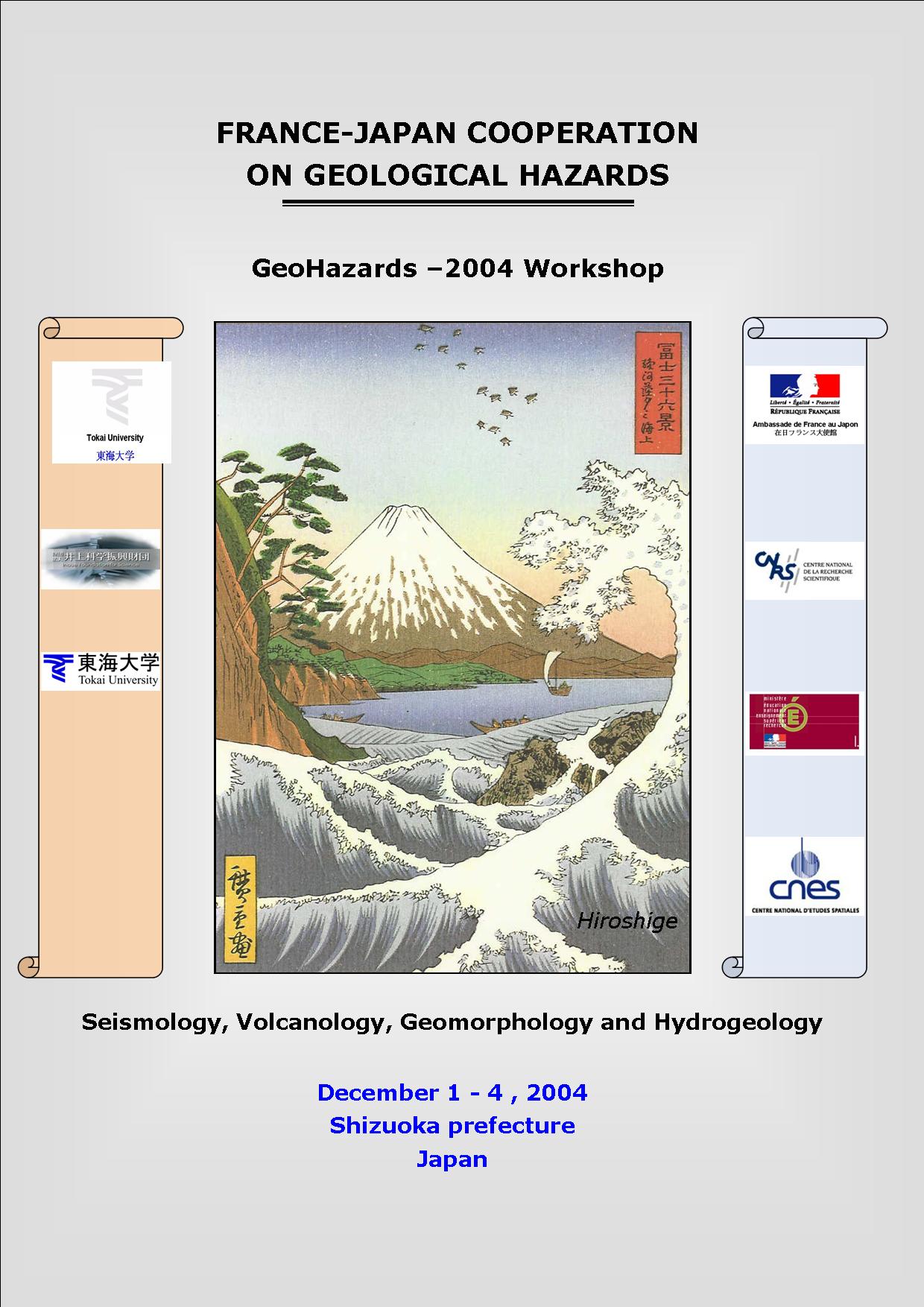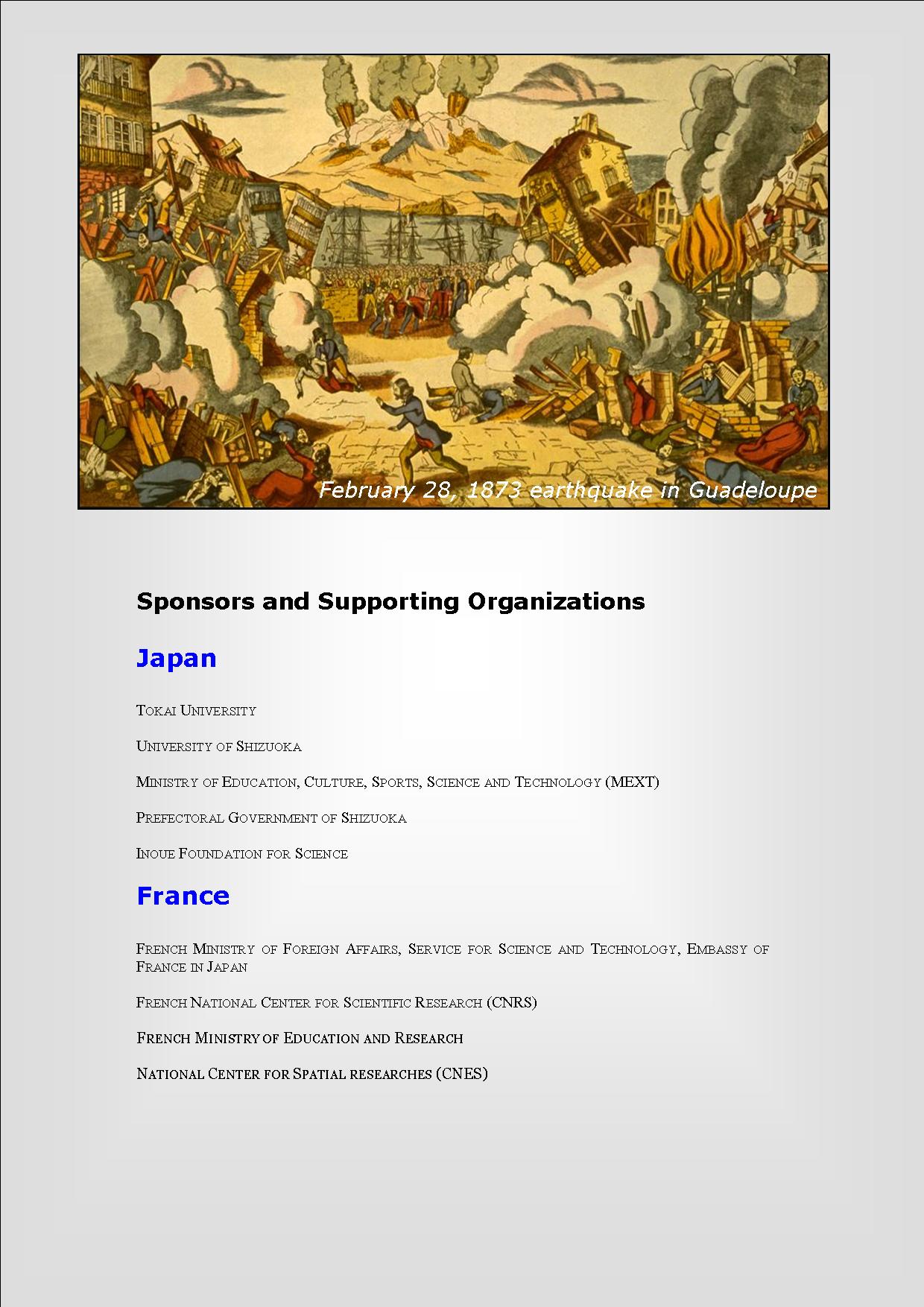DRAFT
France-Japan Workshop on
Geological Hazards
- GeoHazards 2004 -
December 1- 4 , 2004
Shizuoka prefecture
Japan
GeoHazards 2004
Japan is a country which suffers many different types of geological risks. Earthquakes, volcanic eruptions, floods and landslides belong to the daily life of the Japanese population. Concerning earthquakes, devastating Kobe Earthquake, which lost 6432 people, in 1995 is still fresh in our memory. Furthermore, an extensive avalanche hit Minamata city in Kyushu Island in 2003.
Geological hazards are also be real in France. Some active and dangerous volcanoes are located on the French territory; Mount Pelée in Martinique island killed about 30, 000 inhabitants in 1902 while about 50, 000 people were evacuated for several months from Soufrière of Guadeloupe during the 1976-1977 volcanic crisis. Medium seismicity occurs too in France, mainly in the South-East, South-West and East regions. And the number of floods and landslides has significantly increased over the last years.
Geological hazards are thus a common important issue both in France and Japan.
Research activities on these topics are very powerful in Japan and in France as well, and many laboratories and teams are considered as outstanding level institutions in these domains.
In natural hazards bilateral cooperation has been set in the past between several laboratories and teams. These collaborations have given an advanced knowledge about the genesis of these hazards and the way to monitor and mitigate them.
A bilateral and multi-disciplinary meeting on the issues geological hazards will dress the state of the Japan-French cooperation with the objectives to set up new developments in the research area of Natural Hazards.
Both young and senior scientists will be involved in the workshop in order to enhance already existing cooperation and impulse new common researches.
This workshop will concern four domains in which the methodologies to monitor natural hazards, to evaluate the risks and to forecast them will be considered.
The four topics of Geohazards-2004 are:
§ Seismology
§ Volcanology
§ Geomorphology
§ Hydrogeology
About forty scientists from Japan and France will contribute to this workshop.
The workshop will be held in Shizuoka prefecture, located at the foot of Mount Fuji, between the 1st and the 4th of December 2004.
Objectives
The goals of the workshop are first to reinforce the already existing cooperation, secondly to nucleate new collaborations, and to build, in the mid-term, a Japan-France network in the field of Earth Sciences.
To achieve these objectives the workshop will :
1) Be multidisciplinary, allowing the whole participants to exchange information and methods on issues they are not necessarily familiar with.
2) Include young scientists able to ensure some permanence in the existing cooperation and to create new bilateral collaborations.
Four topics will be the core of the workshop:
- Seismology
- Volcanology
- Geomorphology (including ground instabilities and landslides)
- Hydrogeology (including hydro-geological hazards and floods)
Organization and Schedule
The workshop will hold in Shizuoka prefecture, at about 150 km west of Tokyo, between the 1st and the 4th of December 2004 (Granship, http://www.granship.or.jp/index-e.html).
The 4 days seminar will be organized in 4 oral sessions, one for each of the 4 topics. All presentations will be done in plenary sessions. Participants are invited to follow the whole set of sessions. Keynote talks last 25 minutes with 5 minutes of questions. Other oral presentations are scheduled for 20 minutes each (15 minutes talk and 5 minutes of discussion). The last half-day (“5th session”) will be devoted to a general round table discussion to which some institutional representatives from the relevant Japanese and French ministries or research organizations would be invited to take part.
November 30, 2004
Arrival of French participants
December 1
Opening Ceremony
Session1 (Seismology)
December 2
Session 2 (Volcanology)
December 3
Session 3 (Geomorphology)
Session 4 (Hydrology)
December 4
Round table
Mt Fuji excursion
December 5
Departure of French participants
The number of talks will be organized as follow:
Japanese presentations
French presentations
December 1
Session 1 : 5
Session 1 : 5
December 2
Session 2 : 6
Session 2 : 4
December 3
Session 3 : 5 ; Session 4 : 1
Session 3 : 3 ; Session 4 : 3
December 4
Round table
Mt Fuji excursion
December 5
Departure of French participants
Excursion
Izu peninsula and Shizuoka prefecture are among the most active seismic regions in Japan, with a subduction zone of 10 km depth compared with the 40 km depth around Tokyo area.
The Tokai region, which includes Shizuoka prefecture, is one of the most sensitive areas in Japan as far as geological survey and seismic hazards are concerned.
The half-a-day excursion at Mount Fuji, close to the conference center, will allow participants to discover the beauty of the region and the volcanic activity.

